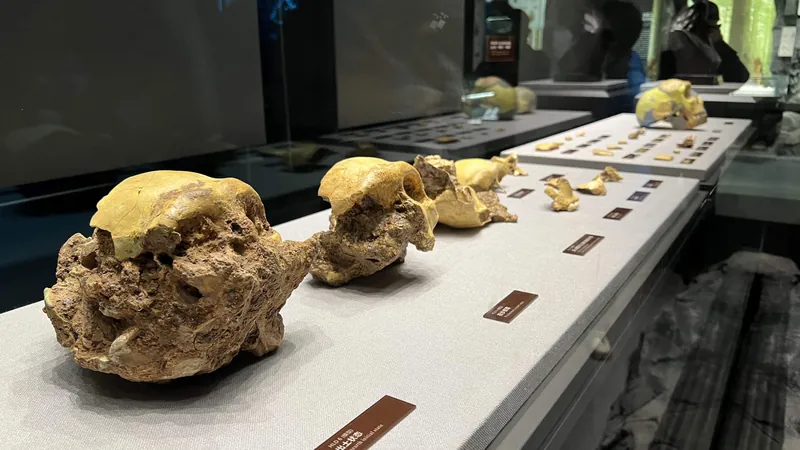
Groundbreaking Fossil Discovery Unveils Secrets of Human Evolution in China!
2024-12-10
Author: Jacob
Introduction
In a stunning revelation for the field of paleoanthropology, Chinese scientists have unearthed a treasure trove of human fossils dating back a staggering 300,000 years at the Hualongdong site in Dongzhi County, Anhui Province. This discovery marks the earliest evidence of human evolution in East Asia, providing vital insights into the ancestry of modern Homo sapiens.
Archaeological Findings
Alongside these ancient human remains, researchers discovered numerous fossilized animal bones and sophisticated stone tools, suggesting that this location was once a bustling hub of activity for early humans. The findings were presented at a recent academic conference in Dongzhi County, drawing nearly 100 researchers and international experts eager to discuss the implications of this groundbreaking work.
Expert Insights
Wu Xiujie, a prominent scientist from the Institute of Vertebrate Paleontology and Paleoanthropology (IVPP) and the lead excavator of the Hualongdong team, shared that the skeletal remains indicate the presence of a large family group comprising over 20 individuals. "They had what you might call a 'dining hall' for butchering and processing food, and they likely took shelter in a nearby karst cave, which unfortunately collapsed before we could excavate it fully," Wu detailed, hinting at the potential for even more significant finds in the future.
Unique Fossil Characteristics
Remarkably, the human fossils display distinctive traits bridging the gap between Homo erectus and modern humans, making them unlike any previously found premodern fossils. This unique blend of physical characteristics is crucial for understanding our evolutionary journey.
Notable Skull Fossil Discovery
A particularly notable find is a skull fossil unearthed in 2015, believed to belong to a teenage girl aged around 13 or 14. Wu described it as revealing a "unique mix of primitive and modern traits," including a flatter face, pronounced eye sockets, and an early version of a chin — all indicators of the evolutionary transition toward Homo sapiens.
Significance of Foot Bone Discovery
Adding to the excitement, a foot metatarsal bone found this year is the only one of its kind discovered in China, providing a glimpse into the walking patterns and stature of these ancient humans. It adds depth to our comprehension of their physicality as they adapted to their environment.
Craftsmanship and Intelligence
Moreover, the finely crafted stone tools signify a high level of craftsmanship among the Hualongdong cave dwellers, underscoring their advanced cognitive abilities. "These ancient people were incredibly intelligent and displayed the early development needed to evolve into Homo sapiens," Wu affirmed.
Conclusion and Future Prospects
Liu Wu, a seasoned researcher with over a decade of excavation experience at the Hualongdong site, asserts that these findings reveal the earliest characteristics of Homo sapiens in East Asia, emphasizing the site’s potential as a critical resource for understanding modern human evolution.
In the shadows of these ancient remains, the Hualongdong site stands poised to illuminate our understanding of human origins and illustrate the evolutionary path that led to the modern humans we are today. As excavations continue, we are on the cusp of uncovering even more secrets that could reshape our narrative about where we come from and our journey through time. Stay tuned for further updates on this extraordinary find!



 Brasil (PT)
Brasil (PT)
 Canada (EN)
Canada (EN)
 Chile (ES)
Chile (ES)
 Česko (CS)
Česko (CS)
 대한민국 (KO)
대한민국 (KO)
 España (ES)
España (ES)
 France (FR)
France (FR)
 Hong Kong (EN)
Hong Kong (EN)
 Italia (IT)
Italia (IT)
 日本 (JA)
日本 (JA)
 Magyarország (HU)
Magyarország (HU)
 Norge (NO)
Norge (NO)
 Polska (PL)
Polska (PL)
 Schweiz (DE)
Schweiz (DE)
 Singapore (EN)
Singapore (EN)
 Sverige (SV)
Sverige (SV)
 Suomi (FI)
Suomi (FI)
 Türkiye (TR)
Türkiye (TR)
 الإمارات العربية المتحدة (AR)
الإمارات العربية المتحدة (AR)